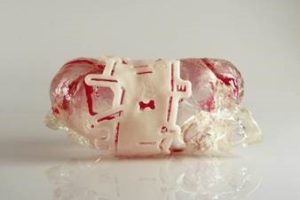
In the last few years, headlines have suggested that the use of additive manufacturing in medicine is a new way to save and improve lives. The truth is, it’s not so new.
Twenty years ago, anatomical models were used for planning complicated surgeries. In 2000, hearing aid cases were 3D printed, and within a few years, they became the industry standard. Medical applications have been a leader in taking 3D-printing technology far beyond product development. The combination of using medical imaging data to create patient-matched devices, and the ability to manufacture structures difficult to produce with traditional technologies, is compelling to an industry always looking for ways to innovate and improve care for patients.
- A VSP Cranial conjoined twins model with guides [Image courtesy of 3D Systems]
- An anatomical model of the brain of conjoined twins [Image courtesy of 3D Systems]
Interest has been fueled by many factors, including the expiration of patents beginning in 2010. As competition intensified, the effort by machine builders to bring down prices accelerated. At the same time, the availability and increased reliability of metal printers and multicolor machines expanded interest and use.
Metal printing systems allowed device manufacturers to produce porous structures for orthopedic implants that would be difficult to produce with traditional methods. For hospitals, the drop in prices and improvement in multicolor machines and materials, as well as development of supporting software for critical segmentation of medical imaging files, facilitated an investment in an area that is not yet included in reimbursable expenses by payers.
SME, a nonprofit organization that promotes advanced manufacturing technology, has been a gathering point for users and developers of additive manufacturing since 1990, when it convened an event that has come to be known as RAPID + TCT. It now counts clinical and medical device additive manufacturing applications as an essential component of the annual convention.
This year at RAPID + TCT, additive manufacturing advancements in the medical industry will be featured prominently throughout the event as part of the Medical Manufacturing Innovations series. One specific keynote, “New Materials for 3D Printing in Medicine,” takes a closer look at how personalized care enabled by additive manufacturing is already making an impact in medicine.
Dr. Ramille Shah, an assistant professor at Northwestern University, will lead the keynote discussion based on her team’s development of an extensive range of tunable 3D-printable biomedical material platforms, including cell-containing (bioprinting) and non-cell-containing inks that provide a wider variety of options for complex soft and hard-tissue engineering applications. This work has already shown promise for creating a functional ovary bioprosthesis with the potential to restore and preserve fertility and hormone function in pediatric cancer survivors; a synthetic hyperelastic “bone” material with unique properties that allow for scalable, surgically friendly bone-defect repair; electrically conductive 3D graphene for nerve and muscle regeneration; and more.Dr. Shah will describe the new biomaterial platforms that have led to these exciting developments and recent efforts to establish an in-hospital, GMP (good manufacturing practice) approved biomaterial 3D-printing center. She will be joined by plastic and reconstructive surgeon, Dr. Sue Jordan, to share some of the ongoing, impactful work and discuss its potential to improve and even save lives.
Dr. Shah and Dr. Jordan will also contribute to a RAPID + TCT panel discussion that focuses on new applications within the biomaterials area. This growth is beyond use of the technology for anatomical models and surgical guides, which are closer to standards of care, and device manufacturers taking advantage of the unique structures additive manufacturing can build. Panelists will discuss some of these applications, the developments making them possible, the similarities and differences between 3D printing with biomaterials and bioprinting, and expectations for impacting patient care.
From manufacturing of end-use surgical devices and personalized implants to bone scaffolds and functioning organ replacements, 3D printing is truly changing lives. At RAPID + TCT, attendees will find in-depth conference sessions covering design and manufacture of implants, dental devices, tissues and more using a variety of additive technologies. To learn more about RAPID + TCT and its Medical Manufacturing Innovations program, or to register for the event, visit rapid3devent.com/mmi. Discuss in the RAPID forum at 3DPB.com.
Lauralyn McDaniel is the Medical Industry Manager at SME.
Subscribe to Our Email Newsletter
Stay up-to-date on all the latest news from the 3D printing industry and receive information and offers from third party vendors.
You May Also Like
Profiling a Construction 3D Printing Pioneer: US Army Corps of Engineers’ Megan Kreiger
The world of construction 3D printing is still so new that the true experts can probably be counted on two hands. Among them is Megan Kreiger, Portfolio Manager of Additive...
US Army Corps of Engineers Taps Lincoln Electric & Eaton for Largest 3D Printed US Civil Works Part
The Soo Locks sit on the US-Canadian border, enabling maritime travel between Lake Superior and Lake Huron, from which ships can reach the rest of the Great Lakes. Crafts carrying...
Construction 3D Printing CEO Reflects on Being Female in Construction
Natalie Wadley, CEO of ChangeMaker3D, could hear the words of her daughter sitting next to her resounding in her head. “Mum, MUM, you’ve won!” Wadley had just won the prestigious...
1Print to Commercialize 3D Printed Coastal Resilience Solutions
1Print, a company that specializes in deploying additive construction (AC) for infrastructure projects, has entered an agreement with the University of Miami (UM) to accelerate commercialization of the SEAHIVE shoreline...


































